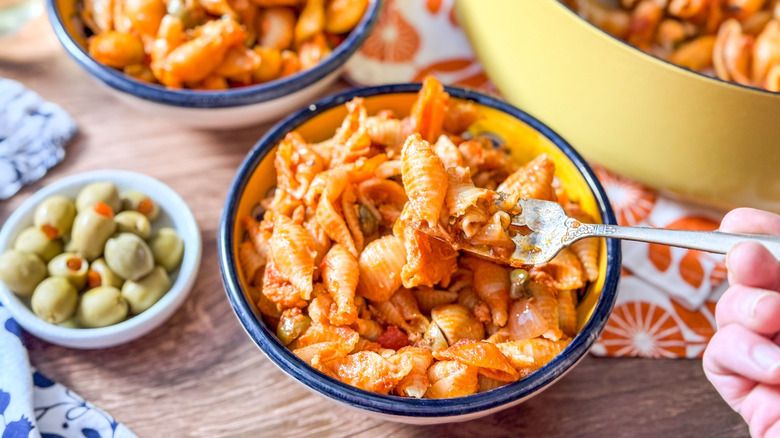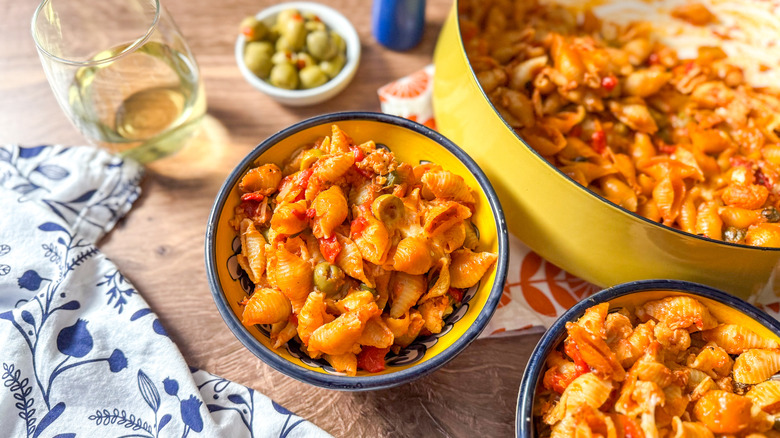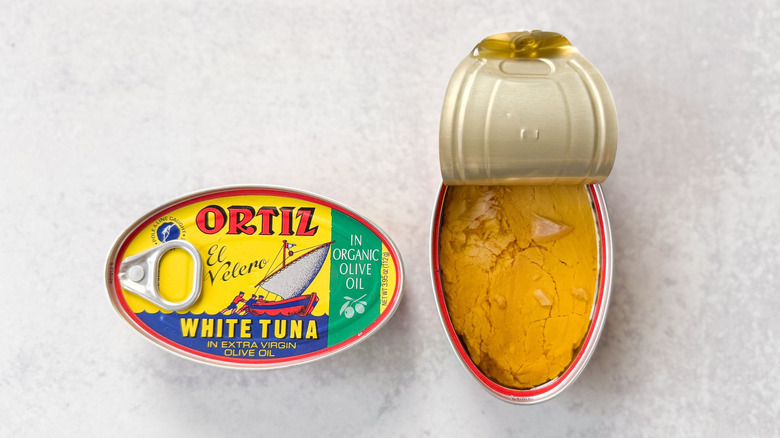Spanish Romesco-Y Tuna Casserole Recipe
If the thought of serving tuna casserole at your next gathering sounds pedestrian, think again. Bring some flamenco flair to the table with this Spanish romesco-y tuna casserole, courtesy of recipe developer Julie Kinnaird. Packed full of flavor reminiscent of a traditional Spanish romesco sauce, this casserole has enough elegance and sophistication to make it the centerpiece of dinner or part of a full tapas spread. The recipe calls on classic Spanish ingredients like smoked paprika, roasted peppers, pimento-stuffed olives, cauliflower, and oil-packed fish, to add a lively and complex depth of flavor that elevates this dish. With these vibrant ingredients, Kinnaird transforms mundane tuna casserole into a feast for the senses.
This recipe comes together quickly because it calls for prepared roasted peppers and tomato puree, and because the entire dish is cooked in one pot — pasta and all. The dish can be prepared in advance and baked right before serving, which makes it perfect for easy entertaining. Pair this dish with additional vegetable tapas, charcuterie, or salads and a chilled Spanish white for a menu that works well in any season.
Gather the Spanish romesco-y tuna casserole ingredients
To achieve authentic Spanish flavor in this recipe, try using ingredients straight from the source — starting with some good Spanish olive oil for sauteing and for drizzling the dish at the end. You will need a variety of popular Spanish vegetables, including white cauliflower, yellow onion, and fresh garlic. To achieve the rich romesco-y flavor, use roasted red peppers (a jarred variety works well) and tomato puree. Flavor the sauce with smoked Spanish paprika, dried oregano, bay leaves, chile flakes, kosher salt, and freshly cracked black pepper. Once the sauce has simmered, you will remove the bay leaves, as they are intended to add a subtle herbaceous flavor but are it's not safe to eat bay leaves. Tinned Spanish tuna and anchovies packed in olive oil give this casserole its distinctive taste of the sea. Pimento-stuffed Spanish manzanilla olives and brine-packed capers add a zesty balance to the richness of the manchego cheese (which is also good on pizza). Kinnaird likes using a medium shell pasta to complete the dish, however, any chunky medium-sized shape will work.
Step 1: Preheat the oven
Preheat oven to 400 F.
Step 2: Heat the olive oil
Heat ¼ cup olive oil in a large oven-safe Dutch oven or braiser over medium-high heat.
Step 3: Add the cauliflower, aromatics, and seasonings
Add the cauliflower, onion, garlic, salt, oregano, smoked paprika, bay leaves, chile flakes, and black pepper.
Step 4: Cook and stir
Cook, stirring frequently, until cauliflower is softened (about 5 minutes).
Step 5: Add the tomatoes and fish
Add the tomato puree, red peppers, tuna and oil from the tins, anchovies, olives, and capers.
Step 6: Simmer the sauce
Simmer for 10 minutes, stirring frequently.
Step 7: Take out the bay leaves
Remove the bay leaves.
Step 8: Add the pasta
Add the pasta and 3 cups of water, mixing well.
Step 9: Cover and simmer
Reduce the heat to low, cover, and simmer for 10-12 minutes or until the pasta is al-dente and most of the liquid has been absorbed.
Step 10: Add cheese and olive oil
Uncover the pan, stir in the cheese, and drizzle the top of the pasta with the remaining 2 tablespoons of olive oil.
Step 11: Bake the casserole
Place the pan in the oven and bake for about 10 minutes until the cheese is bubbly.
Step 12: Preheat the broiler
Set the oven to broil.
Step 13: Broil the pasta
Broil the pasta for 1-2 minutes or until the top is golden brown and crispy.
Step 14: Serve the Spanish romesco-y tuna casserole
Remove the pasta from the oven and serve.
Spanish Romesco-y Tuna Casserole Recipe
Turn a mundane tuna casserole into a sophisticated feast for the senses with the addition of some quality Spanish ingredients in this Romesco-y pasta dish.

Ingredients
- ¼ cup plus 2 tablespoons Spanish olive oil, divided
- 2 cups cauliflower, cut into small flowerets
- ½ cup diced yellow onion
- 2 large cloves garlic, minced
- 1 teaspoon kosher salt
- 1 teaspoon dried oregano
- 1 teaspoon smoked paprika
- 2 bay leaves
- ½ teaspoon chile flakes
- ½ teaspoon ground black pepper
- 1 (14-ounce) can tomato puree
- 1 cup jarred roasted red peppers, drained and diced
- 2 (4-ounce tins) Spanish tuna packed in olive oil
- 3 tinned anchovy fillets packed in oil, drained and minced
- ½ cup Spanish Manzanilla olives with pimientos, drained and halved
- ¼ cup capers in brine, drained
- 12 ounces shell pasta
- 8 ounces Manchego cheese, cut into small cubes
Directions
- Preheat oven to 400 F.
- Heat ¼ cup olive oil in a large oven-safe Dutch oven or braiser over medium-high heat.
- Add the cauliflower, onion, garlic, salt, oregano, smoked paprika, bay leaves, chile flakes, and black pepper.
- Cook, stirring frequently, until cauliflower is softened (about 5 minutes).
- Add the tomato puree, red peppers, tuna and oil from the tins, anchovies, olives, and capers.
- Simmer for 10 minutes, stirring frequently.
- Remove the bay leaves.
- Add the pasta and 3 cups of water, mixing well.
- Reduce the heat to low, cover, and simmer for 10-12 minutes or until the pasta is al-dente and most of the liquid has been absorbed.
- Uncover the pan, stir in the cheese, and drizzle the top of the pasta with the remaining 2 tablespoons of olive oil.
- Place the pan in the oven and bake for about 10 minutes until the cheese is bubbly.
- Set the oven to broil.
- Broil the pasta for 1-2 minutes or until the top is golden brown and crispy.
- Remove the pasta from the oven and serve.
Nutrition
| Calories per Serving | 999 |
| Total Fat | 50.7 g |
| Saturated Fat | 15.6 g |
| Trans Fat | 0.0 g |
| Cholesterol | 74.1 mg |
| Total Carbohydrates | 84.0 g |
| Dietary Fiber | 7.8 g |
| Total Sugars | 10.9 g |
| Sodium | 1,324.0 mg |
| Protein | 53.7 g |
What is Romesco sauce?
Romesco is one of the most popular sauces in Spain, originating in the Catalonia region in the 18th century. Also known as the "fisherman's sauce," romesco is a flavor-packed puree made from cooking down tomatoes, roasted red peppers, nuts (almonds or hazelnuts), smoked paprika, garlic, onion, olive oil, and red wine or sherry vinegar. Multitudes of variations exist on the preparation, but the sauce characteristically has a smoky, subtly spicy, and tangy flavor that works well as everything from a dip to a cooking sauce. Originally meant to enliven bland fish preparations, a good romesco will also elevate meat or vegetable preparations to enticing levels.
In this romesco-inspred tuna casserole, the traditional flavor of this versatile sauce shines through and pairs perfectly with the oil-packed tuna. Romesco is also a natural choice for saucing pasta and in this case, tastes delicious with the nutty flavor of the manchego cheese.
What substitutions can I make in this recipe?
There are plenty of ways you can customize this pantry-friendly recipe. For the tuna, even if you don't have a Spanish variety Kinnaird suggests sticking with an olive oil-packed selection. The oil retains the flavor, so it's a waste to wash it away as you do when you drain water from canned tuna. And if anchovies are not your thing, it is fine to leave them out but you will miss out on some of the delicious umami flavor they impart. For the olives, Italian Castelvetrano or French Picholine will provide a compatible olive flavor — just be sure to get pitted varieties.
For a chunkier sauce, use an equivalent amount of crushed or diced canned tomatoes rather than puree. You can switch up the fresh vegetables in this recipe as well. Try using different shades of cauliflower (orange or purple) and red onion in place of yellow. When it comes to the peppers, Kinnaird says to stick with roasted. Since traditional romesco uses either dried and reconstituted or freshly roasted peppers to achieve the depth of flavor in the sauce, raw bell peppers just won't give the dish the intensity it needs.


















